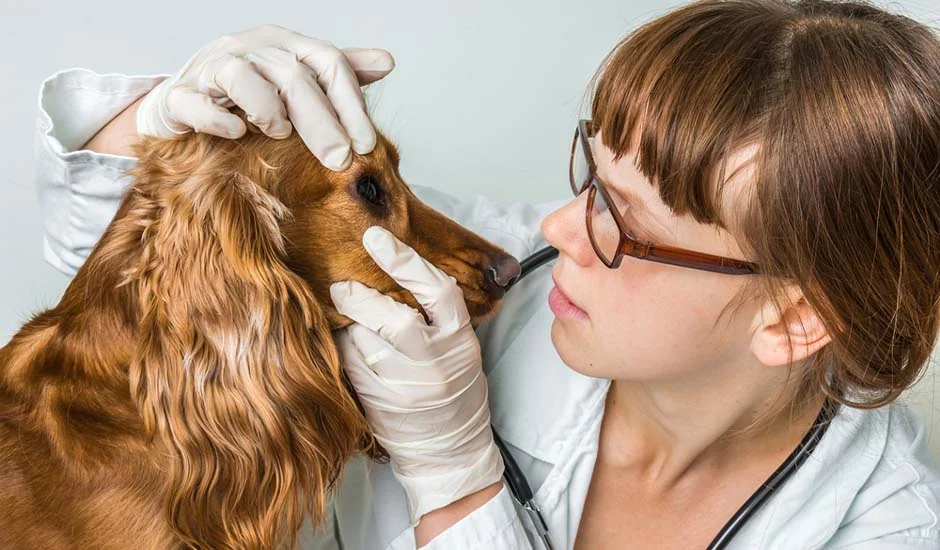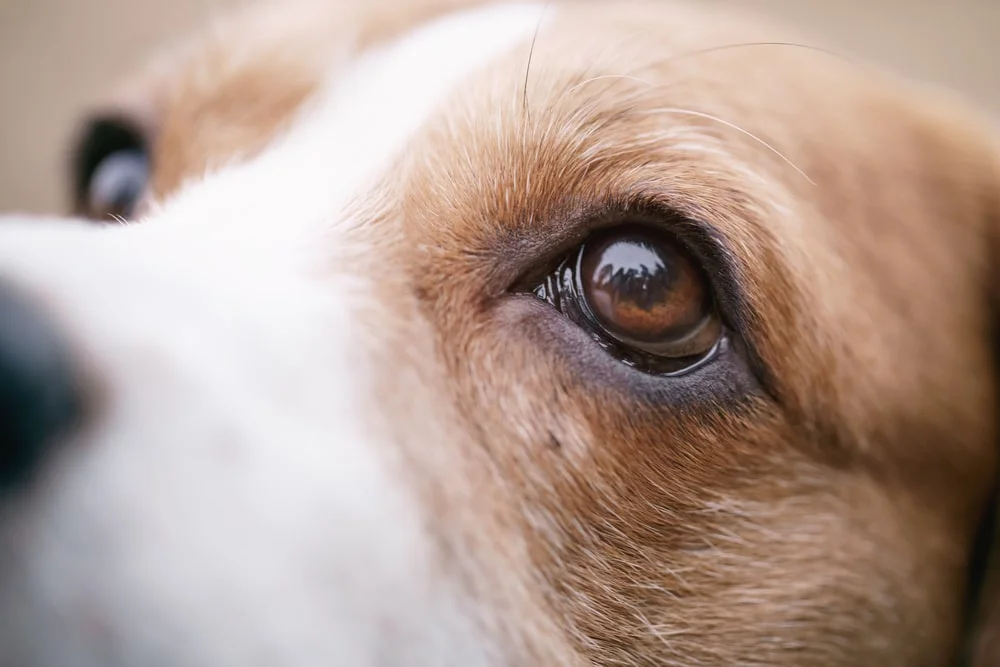Enucleation is surgery to remove your dog’s eye, and the procedure can cost anywhere from a few hundred to a few thousand dollars.1 It’s considered a last resort and usually follows multiple tries to salvage the eye. A vet will only recommend the procedure if the eye is diseased or otherwise irreversibly damaged, but it can prevent cancers from spreading and stop eye pain for your dog.
Enucleation can be a highly successful surgery that improves your dog’s quality of life. But with such a significant surgery affecting one of your dog’s senses, there’s sure to be a lot of questions. Let’s jump into what you need to know about enucleation for dogs.
How Much Does Enucleation Cost?
Dog eye removal surgery costs vary based on your dog’s health and size, the condition of their eye, and your location and vet. Enucleation for dogs can cost anywhere between $475 and $2,000.1 This generally covers any pre-operative diagnostic tests, anesthesia, the surgery itself, hospitalization, and recovery costs. It also factors in things like pain medications, blood tests, and even a cone.
dog’s eye
Dog Eye Removal Surgery Can Be Scary. Vet Bills Don’t Have To Be.
Why Would a Dog Need an Enucleation?
While dog eye removal surgery may seem like an extreme measure, it can actually make a significant difference in your pet’s life. If therapy, medications, or other treatments aren’t enough to heal an eye disease or injury, your vet may recommend enucleation. It can stop the spread of diseases — especially cancer — eliminate pain, and protect your dog’s face from more damage caused by an eye injury or disease.1
This procedure is only done as a last resort, but there are some conditions that may prompt removing your dog’s eye.
- Eye cancer: If the cancer is in or around the eye, removing the eye completely can help stop the spread to other parts of the body.
- Irreversible eye injuries: If the eye was severely damaged from a trauma, it may need to be removed.
- Severe eye infections: If an eye infection doesn’t respond to treatment, eye removal may be the best option to reduce pain and spread.
- Glaucoma: If there’s significant pressure and pain in the eye, the only solution may be to remove it.
What Is the Enucleation Procedure Like?
Before a veterinary ophthalmologist begins the enucleation, they’ll do a pre-operative exam and run some diagnostic tests, like a blood panel.2 Then, they’ll give the dog general anesthesia. Depending on a dog’s health and age, they may also be put on intravenous (IV) fluids.2
Once the dog is prepped for surgery, the vet or vet tech will trim any hair away from the eye and sterilize the skin. They’ll then carefully remove the eyeball and surrounding tissue from the eye socket before stitching it closed. The surgery is straightforward; however, some dogs may need to stay overnight to be monitored.2
How Long Is Enucleation Recovery Time?
After enucleation, dogs may be groggy and otherwise out of it for the first 24 – 48 hours as the anesthesia wears off. You’ll want to keep them still and secluded. Ideally, keep them in a small room or crate, away from kids and other pets.2
It takes 10 – 14 days for the surgical site to heal. Your vet may schedule a post-operative visit to check on their recovery or remove stitches within this time.2
During their recovery, limit your dog’s activity, always keep their Elizabethan collar (cone) on, and follow any other post-operative instructions from your vet. It’s especially important that you don’t let your dog paw at the incision spot.
While most dogs’ appetites return within 24 hours, you can start them on a bland chicken and rice diet if they’re refusing food. Contact your veterinarian if they refuse to eat beyond those first 24 hours.2
Does Enucleation Hurt My Dog?
While the surgery can cause temporary discomfort, your dog may be given dog-safe pain medications to help alleviate acute pain. However, after recovery, dogs are usually pain-free. After all, vets generally perform enucleation to reduce pain from an eye disease or injury.
How Can I Help My Dog Adapt to Enucleation?
While eye removal surgery can significantly improve your dog’s quality of life, it will require them to adapt. Adjusting from having two eyes to just one can be a challenge, since they’ll lose depth perception. Here are some ways you can help them get used to their new lifestyle:
- Follow all post-operative recommendations from your vet to keep their recovery as pain-free as possible.
- Reintroduce them to any family pets under supervision to help them get used to each other after the changes.
- Be respectful of their new blind spot and don’t startle them.
- Avoid rearranging your furniture or home until they’re used to navigating with one eye.
- Pay close attention to your dog as they relearn to do simple things, like taking stairs, eating, and moving around.
- Be watchful of their surroundings as you start to take them back outside and for walks.
- Keep them away from roads and other dangerous situations, since they may not be able to judge distance.
- Give them lots of snuggle time and treats. It’s hard work adjusting to life with one eye, so they’ll need all the encouragement they can get.
Are There Enucleation Alternatives?
There are unfortunately no alternatives for eye removal surgery, as it’s often utilized as a last resort when your dog’s eye doesn’t respond to treatment options to salvage the eye.
After the surgery, if you opt to not have the surgical site stitched up, your vet can replace your dog’s eyeball with a silicone implant.3 The muscles surrounding the eye are left intact, so the silicon eyeball can move and blink as though it were real. However, this is just cosmetic and doesn’t make a significant difference to the dog’s overall health or quality of life. It also has a longer recovery time, and not all dogs are candidates for a dog prosthetic eye.3
Does Dog Insurance Cover Enucleation for Dogs?
MetLife Pet Insurance may help cover dog eye removal costs. However, it may depend on the reason for eye removal. Dog insurance doesn’t cover most pre-existing conditions and may also limit treatment for hereditary conditions.
Your dog’s eye health is important to us. Dog insurance can help you afford surgeries for covered illnesses, such as cherry eye surgery, cataract surgery, or an enucleation. See if dog insurance is worth it for you and your furry friend and get started with a free quote today.
Help Protect Your Pup From Pain
855-270-7387
1 “Enucleation Surgery for Dogs,” Center for Dog Pain Relief, 2023
2 “Pet Eye Removal Surgery (Enucleation),” Anicira
3 “VETERINARY EYE SERVICES: ENUCLEATION/INTRAOCULAR PROSTHESIS/CILIARY BODY ABLATION,” Animal Eye Consultants
Coverage issued by Metropolitan General Insurance Company (“MetGen”), a Rhode Island insurance company, headquartered at 700 Quaker Lane, Warwick, RI 02886, and Independence American Insurance Company (“IAIC”), a Delaware insurance company, headquartered at 11333 N Scottsdale Rd, Ste 160, Scottsdale, AZ 85454. Coverage subject to restrictions, exclusions and limitations and application is subject to underwriting. See policy or contact MetLife Pet Insurance Solutions LLC (“MetLife Pet”) for details. MetLife Pet is the policy administrator. It may operate under an alternate or fictitious name in certain jurisdictions, including MetLife Pet Insurance Services LLC (New York and Minnesota) and MetLife Pet Insurance Solutions Agency LLC (Illinois).
L1023035810[exp1025][All States][DC,GU,MP,PR,VI]



